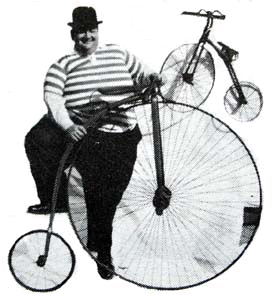 Directory of Bikes!
Directory of Bikes!
- Annual Cycling Events
- Bicycle Accessories
- Bicycle Components
- Bicycle Fit Systems
- Bicycle Manufacturers
- Bike Clothing
- Bike Electronics
- Cycling Associations
- Cycling Magazines
- Cycling Podcasts
- Cycling Teams
- History of Bicycles
- Mechanics of Bicycles
- Nutrition
- Online Bicycle Stores
- Park,Vacation, Resort Tours
- Photo of the Day - Gallery
- Top 10 Bike Sites
- Trail and Bike Route Sites
History of Bicycles | What's New
| |
| Popular Search Categories |
The Draisienne Walking Machine
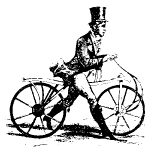 . .In 1817 Baron von Drais invented a walking machine. It would help him get around his royal gardens faster. It was constructed with two same-size in-line wheels, the front one steerable and mounted in a frame which you straddled. The device was propelled by pushing your feet against the ground. Rolling yourself and the device forward in a sort of gliding, walking motion. The machine became known as the Draisienne or popularly called the hobby horse. The Draisienne was made entirely of wood. It enjoyed a short lived popularity as a fad. It was not practical for transportation in any other place than a well maintained pathway such as in a path or garden walk.
. .In 1817 Baron von Drais invented a walking machine. It would help him get around his royal gardens faster. It was constructed with two same-size in-line wheels, the front one steerable and mounted in a frame which you straddled. The device was propelled by pushing your feet against the ground. Rolling yourself and the device forward in a sort of gliding, walking motion. The machine became known as the Draisienne or popularly called the hobby horse. The Draisienne was made entirely of wood. It enjoyed a short lived popularity as a fad. It was not practical for transportation in any other place than a well maintained pathway such as in a path or garden walk.
The Velocipede or Boneshaker
 It took nearly 50 years for the next appearance of a two-wheeled riding machine in 1865. Pedals were applied directly to the front wheel. This machine was known as the velocipede or also called the fast foot. It was popularly known as the bone shaker. It was also made entirely of wood and then later with metal tires. The combination of these with the cobblestone roads of the day made for an extremely uncomfortable bumpy ride. They were also a fad. Indoor bicycle riding academies like roller rinks, could be found in large cities.
It took nearly 50 years for the next appearance of a two-wheeled riding machine in 1865. Pedals were applied directly to the front wheel. This machine was known as the velocipede or also called the fast foot. It was popularly known as the bone shaker. It was also made entirely of wood and then later with metal tires. The combination of these with the cobblestone roads of the day made for an extremely uncomfortable bumpy ride. They were also a fad. Indoor bicycle riding academies like roller rinks, could be found in large cities.
High Wheel Bicycle
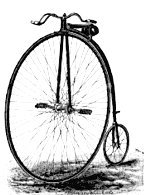 The first all metal machine appeared in 1870. Pedals were atttached directly to the front wheel with no freewheeling mechanism. Solid rubber tires and the long spokes of the large front wheel provided a much smoother ride than its predecessor. The front wheels became larger and larger as makers realized that the larger the wheel, the farther you could travel with one rotation of the pedals. Before this time metallurgy was not advanced enough to provide metal which was strong enough to make small, light parts. You would purchase a wheel as large as your leg length would allow. These bicycles enjoyed a great popularity among young men of means costing an average worker about six month's pay. It’s hey-day being the decade of the 1880s. This machine was the first one to be called a bicycle meaning two wheeled.
The first all metal machine appeared in 1870. Pedals were atttached directly to the front wheel with no freewheeling mechanism. Solid rubber tires and the long spokes of the large front wheel provided a much smoother ride than its predecessor. The front wheels became larger and larger as makers realized that the larger the wheel, the farther you could travel with one rotation of the pedals. Before this time metallurgy was not advanced enough to provide metal which was strong enough to make small, light parts. You would purchase a wheel as large as your leg length would allow. These bicycles enjoyed a great popularity among young men of means costing an average worker about six month's pay. It’s hey-day being the decade of the 1880s. This machine was the first one to be called a bicycle meaning two wheeled.
High Wheel Tricycle
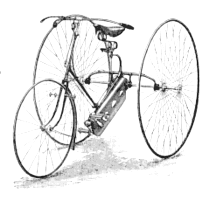 While the men were risking their necks on the high wheels, ladies could take a spin around the park on an adult tricycle. These machines also afforded more dignity to gentlemen such as doctors and clergymen. Rack and pinion steering, the differential, and band brakes are mechanical innovations now associated with the automobile that were originally invented for tricycles.
While the men were risking their necks on the high wheels, ladies could take a spin around the park on an adult tricycle. These machines also afforded more dignity to gentlemen such as doctors and clergymen. Rack and pinion steering, the differential, and band brakes are mechanical innovations now associated with the automobile that were originally invented for tricycles.
High Wheel Safety Bicycle
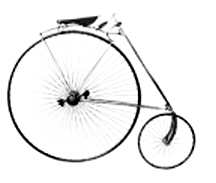 Improvements to the design soon began to be seen, many with the small wheel in the front to eliminate the tipping-forward problem of the High Wheel. These designs became known as high-wheel “safety bicycles”. Since the older high-wheel designs had been known simply as bicycles, they were now referred to as "ordinary bicycles" in comparison with the new-fangled designs, and then simply as "ordinaries."
Improvements to the design soon began to be seen, many with the small wheel in the front to eliminate the tipping-forward problem of the High Wheel. These designs became known as high-wheel “safety bicycles”. Since the older high-wheel designs had been known simply as bicycles, they were now referred to as "ordinary bicycles" in comparison with the new-fangled designs, and then simply as "ordinaries."
Hard-Tired Safety Bicycle
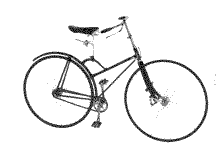 With metal that was strong enough to make a fine chain and sprocket small and light enough for a human being to power, the next design was a return to the original configuration of two same-size wheels. Now, instead of just one wheel circumference for every pedal turn, you could, through the gear ratios, have a speed the same as the huge high-wheel. The bicycles still had the hard rubber tires, and in the absence of the long, shock-absorbing spokes, the ride they provided was much more uncomfortable and bumpy than any of the high-wheel designs but were easier to ride. Many of these bicycles of 100 years ago had front and/or rear suspensions. These designs competed with each other, your choice being the high-wheel's comfort or the safety's safety, but the next innovation tolled the death of the high-wheel design.
With metal that was strong enough to make a fine chain and sprocket small and light enough for a human being to power, the next design was a return to the original configuration of two same-size wheels. Now, instead of just one wheel circumference for every pedal turn, you could, through the gear ratios, have a speed the same as the huge high-wheel. The bicycles still had the hard rubber tires, and in the absence of the long, shock-absorbing spokes, the ride they provided was much more uncomfortable and bumpy than any of the high-wheel designs but were easier to ride. Many of these bicycles of 100 years ago had front and/or rear suspensions. These designs competed with each other, your choice being the high-wheel's comfort or the safety's safety, but the next innovation tolled the death of the high-wheel design.
Pnuematic-Tired Safety Bicycle
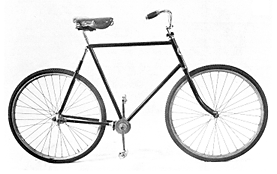 The pnuematic tire was first applied to the bicycle by an Irish veterinarian who was trying to give his young son a more comfortable ride on his tricycle. This inventive young doctor's name was Dunlop. The tire guy. Now that comfort and safety could be had in the same package and that package was getting cheaper as manufacturing methods improved. Everyone now clamored to ride the bicycle. The bicycle was what made the Gay Ninties gay. It was a practical investment for the working man as transportation, and gave him a much greater flexibility for leisure. In 1896 Susan B. Anthony said that "the bicycle has done more for the emancipation of women than anything else in the world."
The pnuematic tire was first applied to the bicycle by an Irish veterinarian who was trying to give his young son a more comfortable ride on his tricycle. This inventive young doctor's name was Dunlop. The tire guy. Now that comfort and safety could be had in the same package and that package was getting cheaper as manufacturing methods improved. Everyone now clamored to ride the bicycle. The bicycle was what made the Gay Ninties gay. It was a practical investment for the working man as transportation, and gave him a much greater flexibility for leisure. In 1896 Susan B. Anthony said that "the bicycle has done more for the emancipation of women than anything else in the world."
Bicycling was so popular in the 1880s and 1890s that cyclists formed the League of American Wheelman (still in existence and now called the League of American Bicyclists). The League lobbied for better roads, literally paving the road for the automobile.
Classic Bicycle
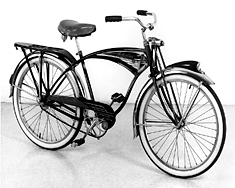 Introduced just after the First World War by several manufacturers, such as Mead, Sears Roebuck, and Montgomery Ward, to revitalize the bike industry (Schwinn made its big splash slightly later), these designs, now called "classic", featured automobile and motorcyle elements to appeal to kids who, presumably, would rather have a motor. If ever a bike needed a motor, this was it. These bikes evolved into the most glamorous, fabulous, ostentatious, heavy designs ever. They were built into the middle '50s, by which time they had taken on design elements of jet aircraft and even rockets. By the '60s, they were becoming leaner and simpler.
Introduced just after the First World War by several manufacturers, such as Mead, Sears Roebuck, and Montgomery Ward, to revitalize the bike industry (Schwinn made its big splash slightly later), these designs, now called "classic", featured automobile and motorcyle elements to appeal to kids who, presumably, would rather have a motor. If ever a bike needed a motor, this was it. These bikes evolved into the most glamorous, fabulous, ostentatious, heavy designs ever. They were built into the middle '50s, by which time they had taken on design elements of jet aircraft and even rockets. By the '60s, they were becoming leaner and simpler.
Current Bicycles
It is the recent history of the bicycle in America that we are more familiar with. The English 3-speed of the '50s through the '70s. The 10-speed derailleur bikes which were popular in the '70s (the derailleur had been invented before the turn of the century and had been in more-or-less common use in Europe since. The mountain bike is popular right now.